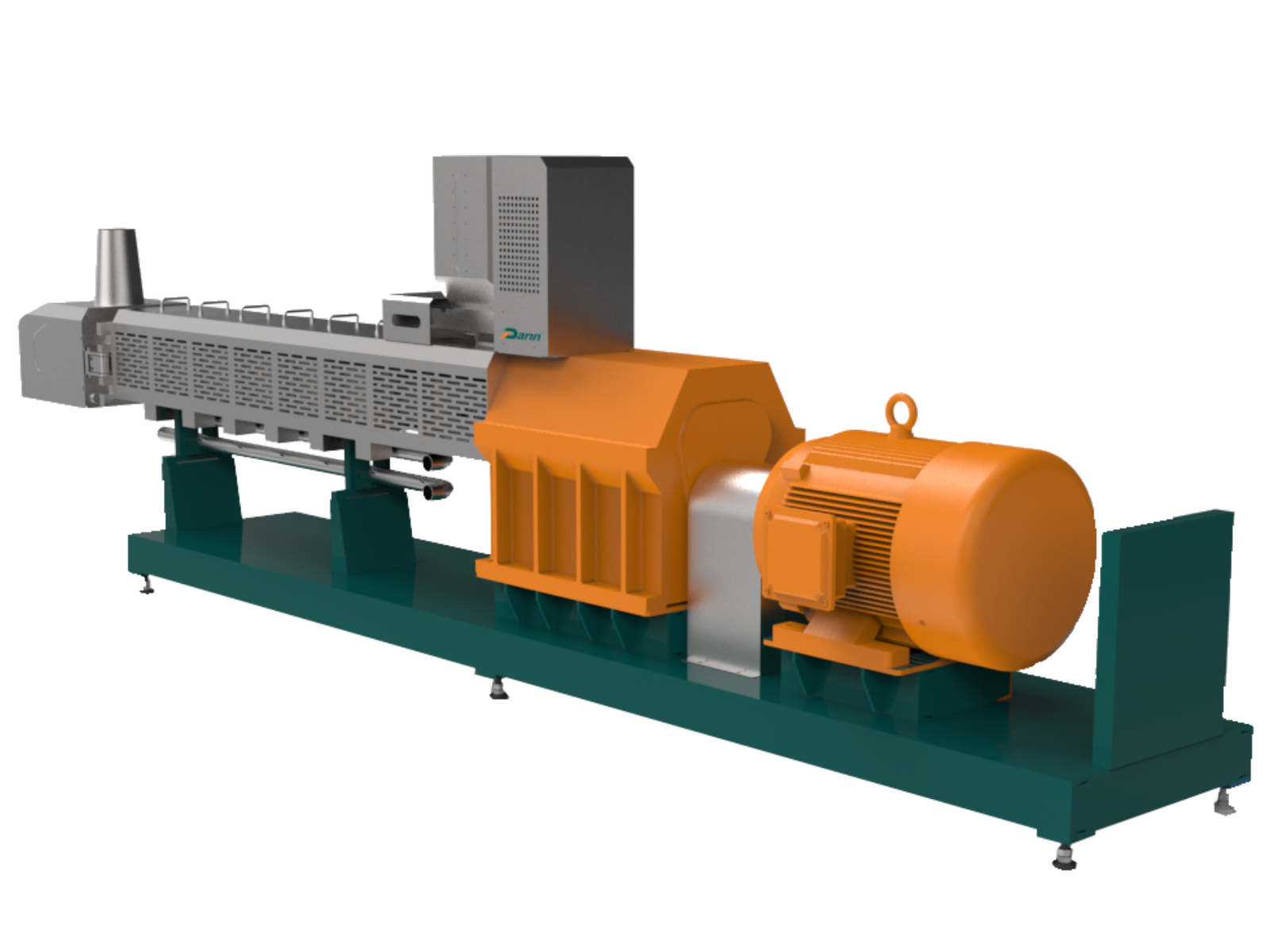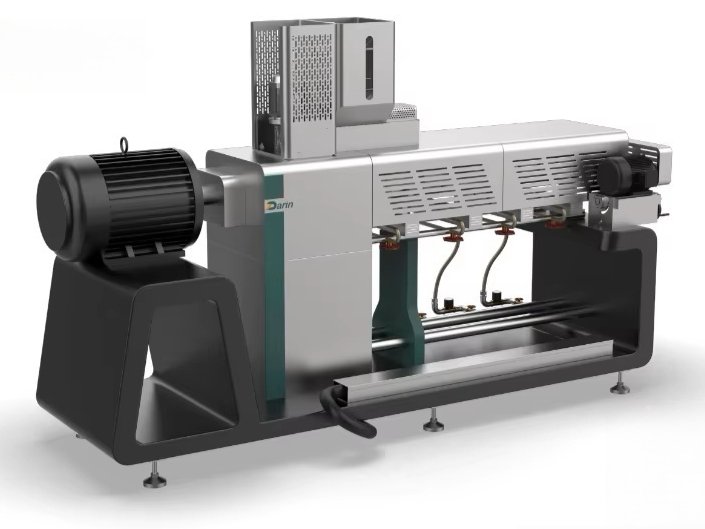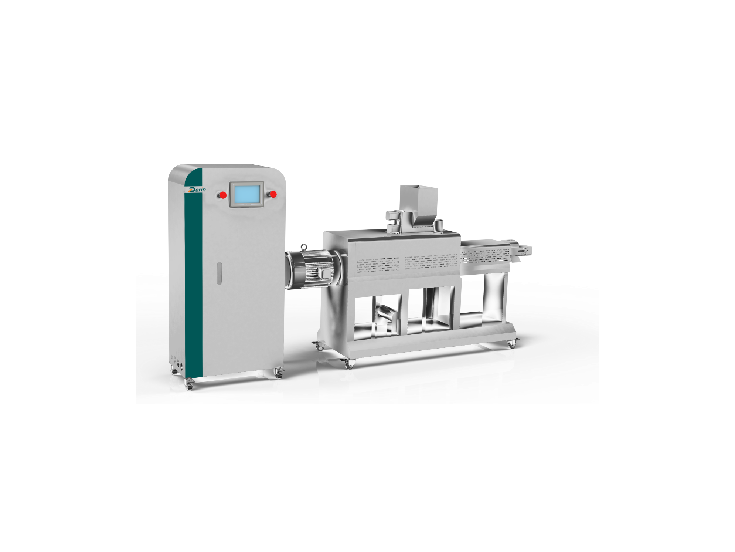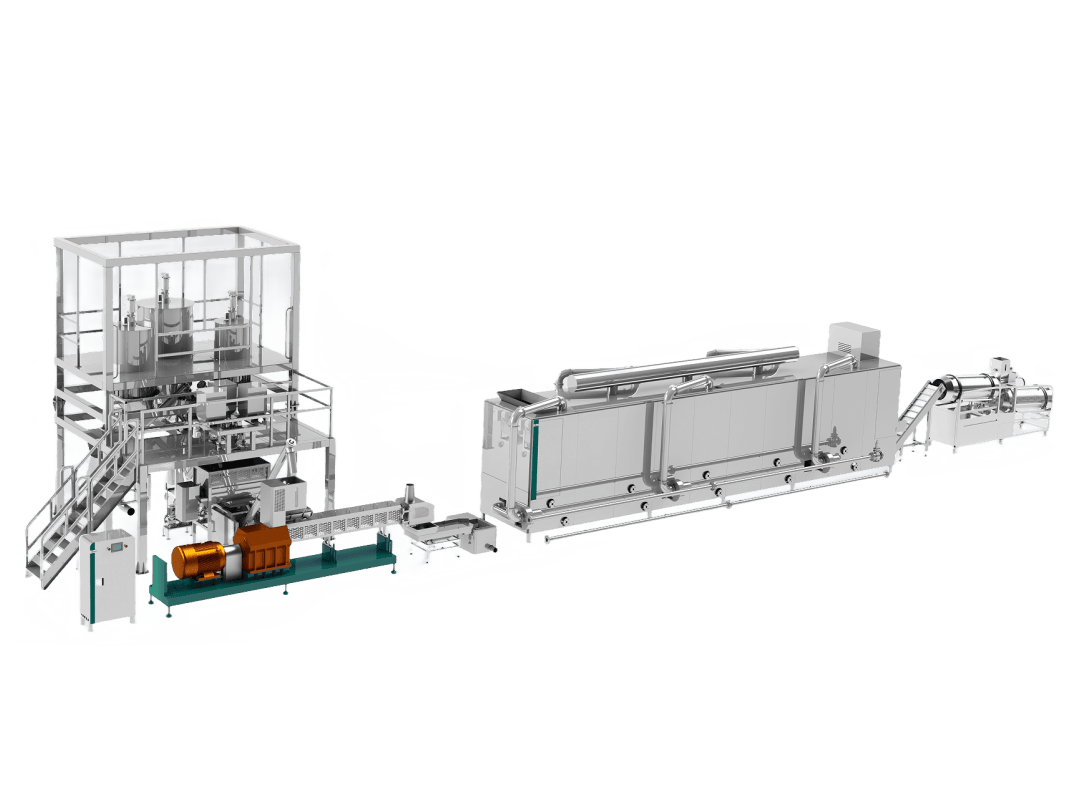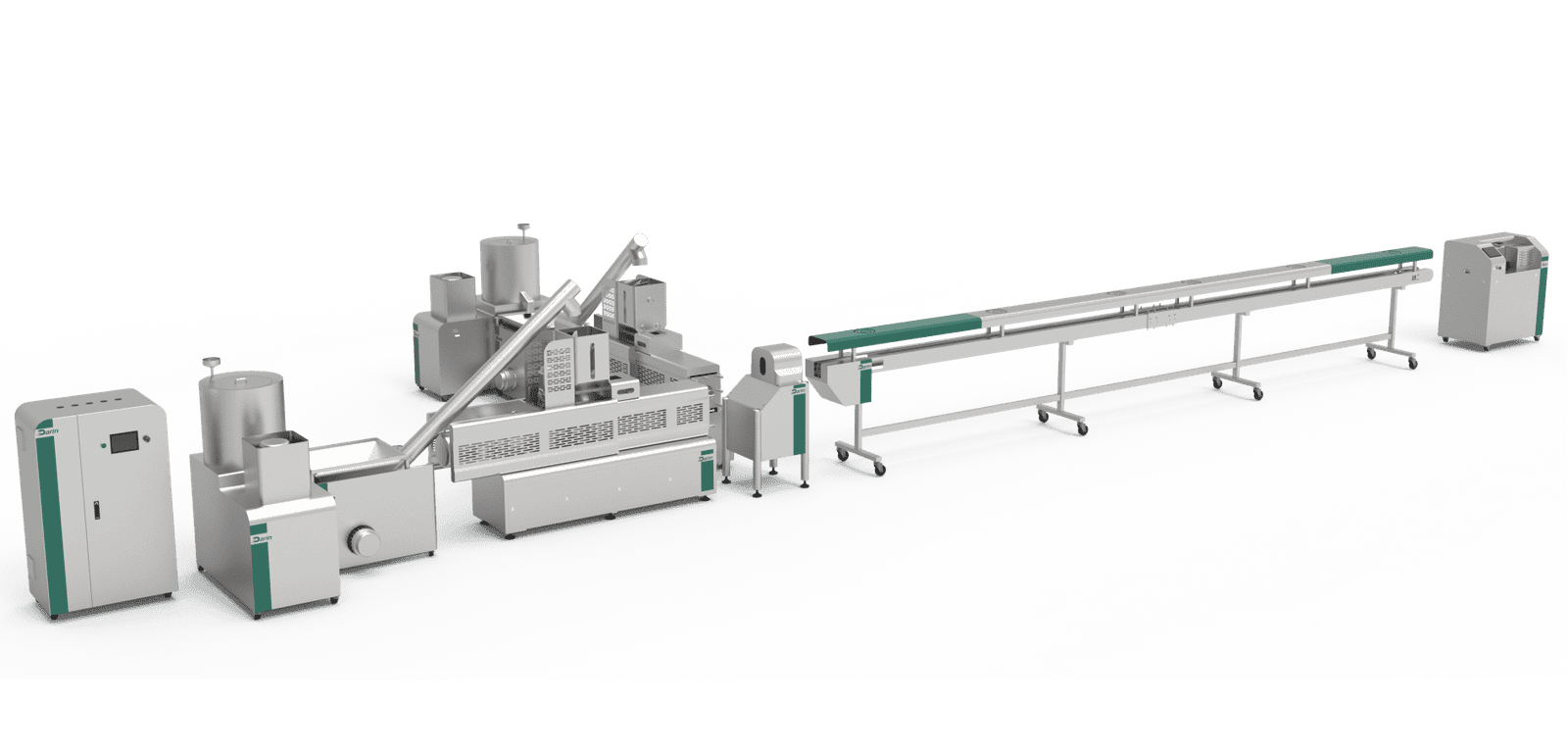
Have you ever gazed into your pet's eyes and wondered about the journey their food takes from raw ingredients to kibble?
Dog food production involves various machines such as mixers, extruders, dryers, and packagers. These machines work together to blend ingredients, shape the food, remove moisture, and package it for distribution. Each type of machine plays a specific role in ensuring the final product is nutritious and safe for consumption.
I remember the first time I stepped into a dog food production facility; it was like stepping into the future. Mixers whirred with precision, combining ingredients with a chef's finesse. The extruders fascinated me most—watching them shape raw mixtures into perfectly uniform kibbles was mesmerizing. It's these machines, each with its unique role, that ensure our pets enjoy safe, nutritious meals. Delving into how each machine functions not only satisfies curiosity but also deepens our appreciation for the intricate dance of technology and care that goes into crafting every bite of dog food.
Mixers are used to blend ingredients in dog food production.True
Mixers combine various ingredients to ensure a uniform blend.
Extruders are used to package the final dog food product.False
Extruders shape the food, while packagers handle packaging.
How Does an Extruder Work in Dog Food Production?
Have you ever paused to wonder how your dog's favorite kibble is crafted? Dive into the world of extruders and discover their pivotal role in pet food production.
In dog food production, an extruder combines, cooks, and shapes ingredients into kibble. It uses heat and pressure to transform raw materials into uniform, digestible pieces, optimizing nutritional value and texture.

The Basics of Extrusion
When I first delved into the fascinating world of pet food production, I was amazed by how integral extrusion is to the process. Imagine taking a blend of meats, grains, and vitamins and magically turning them into perfectly shaped kibble. This journey begins with blending these raw ingredients until they reach a fine consistency.
The Extrusion Process
Picture this: you've got a mix of finely ground ingredients ready to go. It’s a bit like preparing dough for baking, but instead of bread, we’re making something special for our furry friends. Once this mix is fed into the extruder barrel, it embarks on quite the transformation journey.
Inside the extruder, a rotating screw takes charge, pushing the blend through a heated chamber. This isn’t just about cooking; it's about ensuring every morsel is safe and free from pathogens, thanks to the perfect combination of heat and pressure. As the starches gelatinize, the kibble's texture and nutritional profile are meticulously crafted.
Detailed Process Flow:
| Step | Description |
|---|---|
| Mixing | Ingredients are mixed to a uniform consistency. |
| Grinding | Blends are ground to achieve a fine texture. |
| Heating | Heat is applied to cook and sanitize the blend. |
| Shaping | The cooked mixture is forced through dies to shape. |
Advantages of Extrusion
One of the most rewarding aspects of using extrusion is its ability to deliver consistent quality every single time. It's like having a personal chef for your pet's meals. The process ensures each piece is uniform in size and shape—vital for maintaining portion control.
Moreover, extrusion enhances digestibility through heat processing while retaining essential nutrients and eliminating harmful bacteria. It's all about giving our pets food that's not only tasty but also good for them.
These advantages make extrusion the go-to method for crafting top-notch dog kibble1.
Technological Innovations
Advancements in technology have ushered in a new era for extruders. Modern machines now come equipped with digital control panels and automated settings that allow for unprecedented precision and efficiency. This means manufacturers can cater to a wide range of dietary needs with tailored dog food types.
Companies like Darin Machinery2 are leading the charge in these developments, ensuring that as demand for specialized pet diets grows, so too does our ability to meet it.
Understanding how extruders work not only deepens appreciation for the craft but also highlights the complex processes behind delivering nutritious and safe food for our beloved pets.
Extrusion removes harmful bacteria from dog food.True
Heating in the extruder eliminates pathogens, ensuring safety.
Extruders only shape dog food, not cook it.False
Extruders use heat to cook and shape the dog food mixture.
What Role Does a Mixer Play in Pet Food Manufacturing?
Ever wonder what makes your pet's food so consistently delicious and nutritious? Let's dive into the world of mixers, the real MVPs in pet food production.
In pet food manufacturing, mixers are vital for combining diverse ingredients uniformly, ensuring consistent texture and nutrition in each batch. Their efficiency directly affects product quality, safety, and palatability.

Importance of Uniform Mixing
When I first got into the pet food industry, I was blown away by how crucial mixing was. It's like baking a cake—every ingredient has to blend perfectly. A well-mixed batch ensures that each scoop of pet food is loaded with the same goodness, flavor, and nutrients, making it essential for quality control3. Imagine feeding your pet a meal that has everything they need in every single bite.
Types of Mixers Used
The variety of mixers in this industry is pretty fascinating. I remember visiting a plant and seeing these massive mixers at work; it was like a symphony of technology. Here’s a rundown:
- Horizontal Mixers: These are perfect for those massive batches. They're like the powerhouses of dry ingredient blending.
- Vertical Mixers: More for the small-scale operations, using less energy but still giving a thorough mix.
- Continuous Mixers: Picture an assembly line—these are all about consistent flow, essential for nonstop production.
Here's how they stack up:
| Type | Capacity | Efficiency | Best For |
|---|---|---|---|
| Horizontal | Large batches | High | Dry ingredients |
| Vertical | Small batches | Moderate | Wet or moist ingredients |
| Continuous | Continuous flow | Very High | Consistent mass production |
Impact on Product Quality
Mixers don't just mix—they shape the very texture and feel of pet food. They help control the product's moisture and prevent ingredient segregation during processing and packaging. I’ve seen firsthand how poor mixing can lead to uneven cooking or even make a product unappealing to pets.
They also play a role in managing particle size distribution, which affects how the food looks and how easily pets can digest it. It's amazing to think about how every turn of the mixer blade can influence so much.
Enhancing Nutritional Value
Mixers are also the unsung heroes in ensuring that every nutritional supplement or vitamin is perfectly distributed. This is especially critical for those specialized pet foods aimed at particular dietary needs. I always emphasize understanding different mixers and their functionalities because it's a game-changer for manufacturers looking to improve their products.
By diving into industry standards4 for mixing processes, manufacturers can unlock new levels of production efficiency and quality. Every time I witness the process, it feels like watching magic happen—turning raw ingredients into something that nourishes and delights our furry friends.
Horizontal mixers are best for wet ingredients.False
Horizontal mixers are ideal for dry ingredients, not wet ones.
Continuous mixers offer high efficiency for mass production.True
Continuous mixers maintain consistent output, making them efficient for mass production.
Why Are Dryers Essential in Dog Food Production?
Ever wondered what keeps your dog's food fresh and tasty? Dive into the role dryers play in ensuring quality pet meals.
A dryer in the dog food process removes moisture, preventing microbial growth and extending shelf life. It ensures nutritional value retention, providing safe and appealing food for pets.

The Role of Moisture Control
Picture this: You're whipping up a batch of homemade cookies, only to find they've gone stale before the week is out. That's what high moisture does—it invites microbial growth, leading to spoilage. In the pet food industry5, keeping that moisture in check is crucial. Dryers take on this mighty task, ensuring every nugget of kibble stays fresh and safe for much longer.
| Moisture Level | Effect on Dog Food |
|---|---|
| High | Risk of spoilage |
| Low | Prolonged shelf life |
Nutritional Preservation
I remember the first time I realized how delicate nutrients are when exposed to heat. It was during a family barbeque when my perfectly grilled veggies tasted less vibrant because I’d left them on too long. Similarly, in dog food production, maintaining the right drying parameters ensures all those vital nutrients stay intact. By controlling temperature and time, we can ensure your pets get all the vitamins and minerals they need.
Ensuring Product Consistency
Have you ever bitten into a cookie only to find it half-baked in the middle? Inconsistent textures are a letdown, whether for us or our furry friends. Dryers help achieve that perfect consistency in dog food, making each bite as satisfying as the last. This consistency is particularly crucial for premium brands that pride themselves on quality assurance6.
Enhancing Palatability
Think about your favorite meal—the aroma alone can make your mouth water! The drying process impacts flavor and aroma, which are key to making food appetizing. A well-dried dog food retains its natural flavors, making it more appealing without needing artificial additives. As someone who values health-conscious choices, I appreciate how this caters to pet owners who feel the same.
Technical Considerations in Dryer Selection
Choosing the right dryer is like finding the perfect pair of jeans—it's all about fit and function. Manufacturers look at factors like energy efficiency, capacity, and the latest technology advances.
- Energy Efficiency: Reducing energy consumption while maintaining performance.
- Capacity: Handling large volumes to meet production demands.
- Technology: Innovations like microwave and vacuum dryers for improved efficiency.
Understanding these aspects helps guide decisions on investments in machinery7, whether upgrading existing systems or starting anew.
Dryers prevent microbial growth in dog food.True
Dryers remove moisture, reducing the risk of spoilage and microbial growth.
High temperatures in dryers enhance dog food nutrition.False
Excessive heat can degrade sensitive nutrients, reducing nutritional value.
How Do Packaging Machines Ensure Dog Food Quality?
Ever wondered how your dog’s kibble stays fresh and safe until it reaches their bowl?
Packaging machines ensure dog food quality by automating sealing, reducing contamination risks, and using advanced technologies like vacuum sealing to preserve freshness. This guarantees consistent quality from production to consumer.

The Role of Automation in Packaging
I remember when I first toured a state-of-the-art pet food packaging facility. Watching the machines in action was like witnessing a well-choreographed dance. Automation is key here; it minimizes human contact, which significantly reduces the chances of contamination. Think of robotic arms and conveyors working in perfect harmony, ensuring each bag of dog food is sealed with precision, protecting it from external contaminants.
Automation in packaging reduces human contact with dog food, minimizing contamination risks. Machines like robotic arms and conveyors ensure precise handling and sealing8, preventing exposure to external contaminants. Automated systems also streamline processes, enhancing efficiency and consistency.
Advanced Sealing Technologies
Let me tell you about the magic of advanced sealing techniques, like vacuum sealing and MAP (Modified Atmosphere Packaging). It's a bit like how I used to vacuum-seal my homemade meals for camping trips—removing air from the package to keep the food fresh for longer. In the pet food world, these methods prevent oxidation and spoilage, ensuring that each meal your furry friend gets is as fresh as the day it was packed.
Sealing techniques such as vacuum sealing and modified atmosphere packaging (MAP) are used to maintain dog food freshness. Vacuum sealing removes air from packages, preventing oxidation and spoilage. MAP replaces oxygen with inert gases, extending shelf life.
| Technology | Function | Benefits |
|---|---|---|
| Vacuum Sealing | Removes air | Prevents oxidation |
| MAP | Replaces oxygen | Extends shelf life |
Importance of Quality Control Measures
Back in the day, my meticulous grandmother would inspect each jar she canned for defects. Similarly, these packaging machines are equipped with sensors that detect any inconsistencies, ensuring only perfectly sealed packages make it to market. Regular quality assessments9 are part of the routine, maintaining high standards that even grandma would approve of.
Quality control involves inspecting packages for defects like leaks or weak seals. Machines equipped with sensors detect inconsistencies, ensuring only defect-free packages reach consumers.
Compliance with Industry Standards
With machines designed to meet international standards like CE and ISO certifications, we ensure that each package of dog food not only meets but exceeds global quality expectations. This compliance is crucial for maintaining consumer trust and ensuring that our products can be distributed worldwide.
Packaging machines must adhere to international standards like CE and ISO certifications. These standards ensure machinery is safe and efficient, meeting global requirements for pet food quality.
Sustainable Packaging Solutions
Sustainability is more than just a buzzword; it's a necessity. I’ve seen a shift towards eco-friendly materials, like biodegradable and recyclable options. These choices help reduce our environmental footprint while maintaining product integrity. Our packaging machines are now adept at handling these innovative materials efficiently.
With increasing demand for eco-friendly products, many companies are adopting sustainable packaging materials. Biodegradable and recyclable options reduce environmental impact while maintaining product integrity.
Monitoring and Feedback Systems
In my experience, keeping an eye on things is essential—like monitoring how much sun my plants get to keep them thriving. Similarly, real-time monitoring systems track packaging parameters such as temperature and humidity. With feedback loops, we can make immediate adjustments, ensuring optimal conditions are maintained throughout the process.
Real-time monitoring systems track packaging parameters like temperature and humidity. Feedback loops allow for immediate adjustments,
enhancing process efficiency10and guaranteeing the highest quality product for our furry consumers.
Automation reduces contamination in dog food packaging.True
Automated systems minimize human contact, reducing contamination risks.
Vacuum sealing increases oxidation in dog food packages.False
Vacuum sealing removes air, thus preventing oxidation and spoilage.
What Are the Latest Innovations in Dog Food Machinery?
Ever wondered how the food you give your furry friend is made? The world of dog food machinery is evolving, and it's fascinating!
The latest innovations in dog food machinery include automated systems, AI-driven analytics, and energy-efficient designs. These technologies enhance production efficiency, ensure consistent quality, and reduce environmental impact, catering to the growing demand for premium pet food products.

Automation and Robotics in Dog Food Production
Automation in dog food manufacturing11 has truly revolutionized the industry. When I first walked into a modern dog food production facility, I was mesmerized by the seamless choreography of machines whirring together like a well-rehearsed dance troupe. These sophisticated systems take on tasks like mixing, forming, and packaging with precision that's hard to match. Robotic arms and conveyor systems ensure that each product meets strict quality standards.
Example: A state-of-the-art robotic system can manage multiple packaging lines simultaneously, significantly boosting output while maintaining precision.
AI and Machine Learning Applications
Imagine a world where machines don't just work—they think. That's the reality today, with AI-driven analytics stepping into the spotlight. During a visit to one of our partner facilities, I saw firsthand how AI algorithms12 optimize ingredient mixes. This technology doesn't just keep the assembly line moving; it anticipates maintenance needs and tweaks recipes on-the-fly based on real-time nutritional data and consumer preferences.
Example: AI can analyze data to suggest ingredient adjustments in real-time, enhancing the nutritional value of dog food products.
Sustainable and Energy-Efficient Designs
Sustainability isn't just a buzzword; it's a necessity. Manufacturers are increasingly focusing on reducing their carbon footprints13. I’ve always been passionate about this cause, and seeing how new machinery designs incorporate energy-efficient components warms my heart. These machines use recyclable materials and waste-reduction technologies, aligning with global sustainability goals.
Example: Watching an advanced extrusion system that uses less energy while producing minimal waste was a pivotal moment for me—it felt like witnessing the future of eco-friendly manufacturing.
Advanced Quality Control Systems
Ensuring that each kibble is perfect might sound like an exaggeration, but not in the world of dog food production. Modern machinery now includes advanced quality control systems equipped with infrared sensors and high-resolution cameras.
| Technology | Benefits |
|---|---|
| Infrared Sensors | Detects moisture content for consistent texture |
| High-Resolution Cameras | Identifies defects in color or shape |
| Real-Time Data Analysis | Provides instant feedback for quality adjustments |
I once stood beside a machine that scanned each piece for inconsistencies in texture and color, ensuring only top-quality products leave the facility. The technology is remarkable, giving real-time feedback and adjustments to maintain the highest standards.
By embracing these innovations, manufacturers can not only boost efficiency but also ensure that their products meet the highest standards of quality and sustainability. Every step forward in this technological journey reflects our commitment to providing premium pet food products for pet owners who want nothing but the best for their companions.
Automation reduces human error in dog food production.True
Automated systems streamline processes, minimizing human errors and boosting efficiency.
AI increases downtime in dog food machinery.False
AI predicts maintenance needs, reducing downtime and extending machinery lifespan.
How Can Manufacturers Choose the Right Equipment for Dog Food Production?
Choosing the right equipment for dog food production isn't just a technical decision—it's a journey into the heart of quality and efficiency.
Manufacturers should consider production capacity, energy efficiency, compliance with sanitation standards, and technological innovation when selecting equipment for dog food production. These factors ensure efficient operations and high-quality output.

Assessing Production Capacity
I remember the first time I had to make a decision on scaling our operations. It felt like standing at the edge of a vast ocean of possibilities. The right machinery can make or break the ability to meet demand without sacrificing quality. So, whether you're a massive operation like some of my clients or just starting out, matching your equipment to your production capacity is key. Large-scale manufacturers14 might need those powerhouse machines, while smaller companies could benefit from more nimble setups.
Energy Efficiency and Cost Considerations
Once, during a factory tour, I saw a machine that was an absolute energy guzzler—like leaving all your lights on and wondering why the bill's so high! That's why energy efficiency isn't just about being eco-friendly; it's also about long-term savings. These days, machines come with fancy tech that cuts down on energy use, so keep an eye out for those ratings or certifications that scream "I'm energy-efficient!"
Compliance with Sanitation Standards
There was a time when one of my partners had a minor crisis due to hygiene issues. It was a hard lesson that taught me how crucial sanitation is in this industry. You want machines that are practically self-cleaning—think stainless steel and automated systems—so you're not constantly worrying about contamination.
| Feature | Importance |
|---|---|
| Stainless Steel | Durability & Hygiene |
| Automated Cleaning | Reduces Manual Labor |
| Sealed Compartments | Prevents Contamination |
Technological Advancements
Remember when smartphones suddenly started doing everything? That's happening with dog food machinery too! With features like real-time monitoring and AI-driven processes, you're not just keeping up—you're staying ahead. It's like having a supercomputer for your pet food production line.
Global Standards15 and Certifications
Working internationally means playing by the rules everywhere. When I think about global standards, it's like having a universal stamp of approval that says, "Hey, we do things right here!" CE and ISO certifications are those stamps, ensuring your equipment is reliable across borders.
By considering these factors, manufacturers can make smart choices that not only meet today's demands but also set the stage for future growth. It's all about aligning with your business goals while keeping an eye on the horizon.
High-capacity machines are essential for small-scale manufacturers.False
Small-scale manufacturers prioritize flexibility over high capacity to meet demand.
Energy-efficient equipment reduces both costs and environmental impact.True
Energy-efficient machinery minimizes operational costs and environmental footprint.
Conclusion
Dog food production utilizes machines like mixers, extruders, dryers, and packagers to ensure safe, nutritious kibble through precise blending, shaping, moisture control, and packaging processes.
Discover how extrusion shapes and cooks ingredients into nutritious dog kibble. ↩
Learn about Darin Machinery's innovative extruder technologies for enhanced pet food production. ↩
Learn why uniform mixing is crucial for maintaining consistent nutritional quality in pet food. ↩
Explore guidelines and best practices for effective mixing in pet food manufacturing. ↩
Explore the significance of dryers in maintaining pet food quality and safety through moisture control. ↩
Discover why consistency is vital for premium pet food brands to maintain quality assurance. ↩
Learn about innovative drying technologies that enhance efficiency and product quality in pet food production. ↩
Explore how automation minimizes contamination and enhances efficiency in pet food packaging processes. ↩
Discover how quality control ensures defect-free packaging in the dog food industry. ↩
Learn how real-time monitoring systems optimize packaging conditions for better quality. ↩
Discover how automation is transforming dog food production with increased speed and efficiency. ↩
Learn how AI-driven predictive maintenance minimizes downtime and enhances equipment longevity. ↩
Explore how sustainable machinery designs contribute to reducing environmental impact. ↩
Explore options for high-capacity equipment suitable for large-scale production to meet market demand efficiently. ↩
Learn about essential certifications like CE and ISO 9001 to ensure compliance with international quality standards. ↩


